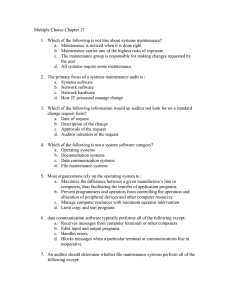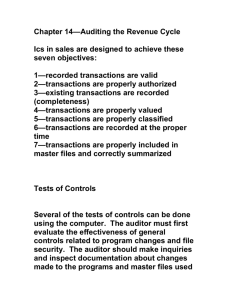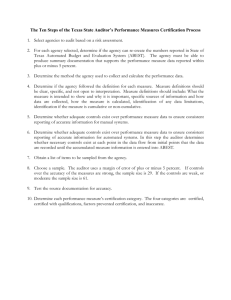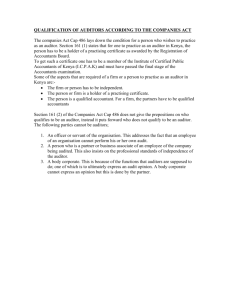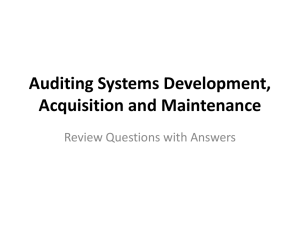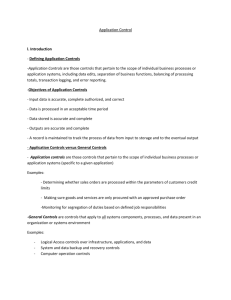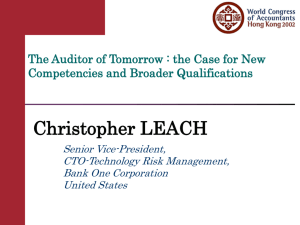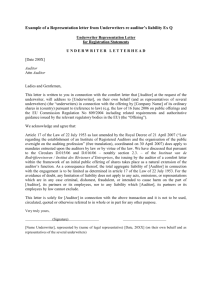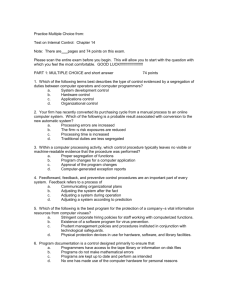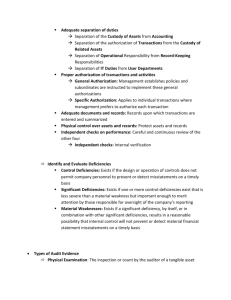DHN Conference Notes 12.11 – Financial Management
advertisement
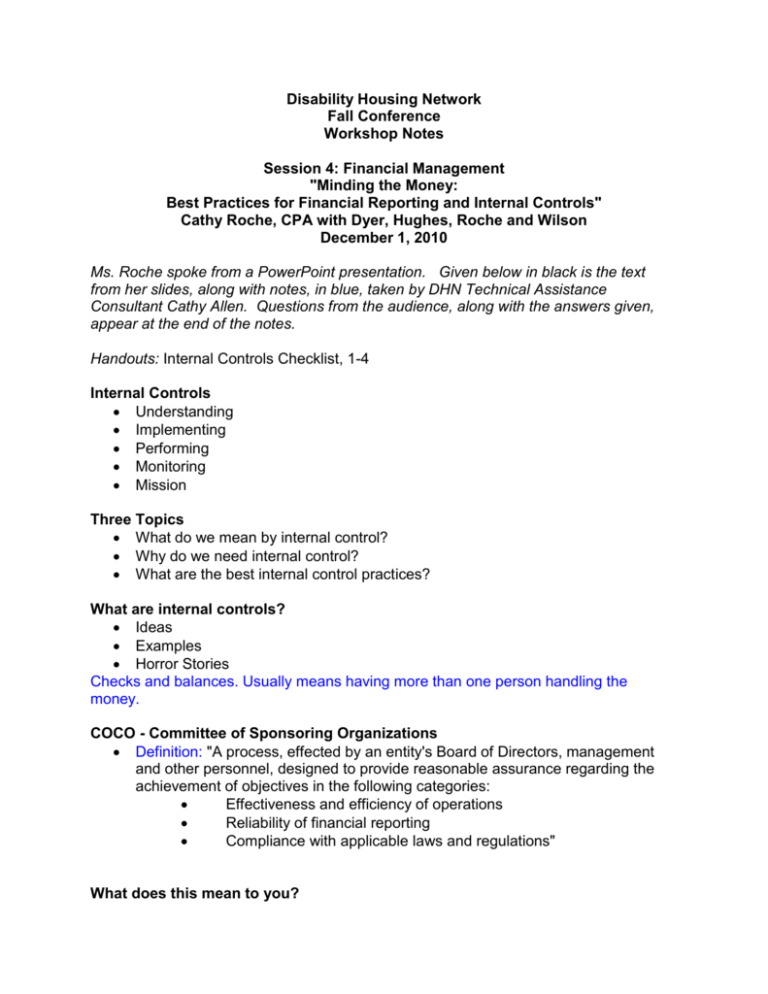
Disability Housing Network Fall Conference Workshop Notes Session 4: Financial Management "Minding the Money: Best Practices for Financial Reporting and Internal Controls" Cathy Roche, CPA with Dyer, Hughes, Roche and Wilson December 1, 2010 Ms. Roche spoke from a PowerPoint presentation. Given below in black is the text from her slides, along with notes, in blue, taken by DHN Technical Assistance Consultant Cathy Allen. Questions from the audience, along with the answers given, appear at the end of the notes. Handouts: Internal Controls Checklist, 1-4 Internal Controls Understanding Implementing Performing Monitoring Mission Three Topics What do we mean by internal control? Why do we need internal control? What are the best internal control practices? What are internal controls? Ideas Examples Horror Stories Checks and balances. Usually means having more than one person handling the money. COCO - Committee of Sponsoring Organizations Definition: "A process, effected by an entity's Board of Directors, management and other personnel, designed to provide reasonable assurance regarding the achievement of objectives in the following categories: Effectiveness and efficiency of operations Reliability of financial reporting Compliance with applicable laws and regulations" What does this mean to you? Integrating a system that covers an organization's Activities Plans Attitudes Policies This system will: Direct Monitor Measure - what people are producing. These are the financial reports. What does this really mean to you? Your organization will have assurance that it will reach its objectives and mission. Internal Control in an Organization Affects every aspect of organization You can't run an organization without internal control. Defines good management Success depends on people Most effective when central to organizational culture Provides a level of comfort These are integrated into an organization and affects every element of the organization. What purpose does it serve? Discuss What internal control can/should do Promote orderly, economical, efficient, effective operations Produce quality products and services Safeguard resources Promote adherence to laws and contracts Develop and maintain financial and management data Accurately present data Quality financial reports The last two are closely related. Internal controls protect against loss due to fraud, waste and human error. Internal Controls Depend on People The tone of an organization is set at the top. The board should continually monitor staff, vendors and customers. Sometimes a person's position in the organization determines where they are in the system of internal controls. The attitude of the people involved determines the success of the program. Everyone in the organization has a role in the system. It is developed by people, conducted by people and holds people accountable. It varies greatly from organization to organization. There is no cookie cutter, but there are some general principles. 5 Components (from Committee of Sponsoring Organizations) Control environment - tone is set at top Risk Assessment - determining where you are vulnerable. Each side of the balance sheet has its own risks. These need to be identified, then plan for monitoring and measuring. Control Activities - everyday controlling, accounting policies and procedures (invoice approval procedure, for example.) Information/Communication - first step is gathering information. Identify where the financial statements are off, then communicate t responsible employees. Monitoring - Make sure all relevant documents are being presented. This is a key aspect of internal controls. Practical Internal Controls Accounting policy and procedures - Manual. Put it in writing. Helps organizations know who performs which function. Segregation of duties - Don't have one person with authority to create, execute, review and monitor all transactions. Get others involved. If your organization is very small, pull in someone from the board such as the treasurer. The board has responsibility. Important new policies - Whistleblower policy, for everyone in the organization. If someone sees something wrong, they should be able to go to someone in the organization to tell. Conflict of interest policy. The organization should know if the board or trustees have other business interests that would conflict with responsibilities for their organization. IT general controls - control access to electronic data, especially when transitioning from one system to another. Much can go wrong. Key Control Examples Cash receipts, revenues, receivables - endorse checks immediately, maintain cash receipts journal, including any restriction on use. Cash disbursements, expenses, payments - prepare authorization of purchase orders, review and reconcile credit card statements and bank statements Monitoring internal and external - auditors assure the public that the organization is using resources wisely. The auditor will provide a letter regarding the internal controls. Management helps to do this internally, helps establish new goals, correct errors and revise procedures. Internal Controls Checklist See handouts: four internal controls checklists. These were downloaded from the internet. Choose one that seems most closely sited to your organization and change it to meet your needs. Takeaway Message Internal Controls matter Take them seriously They help your organization achieve its mission Your auditor takes them seriously Q. We are a very small organization. How can we make sure our deposits are checked and balanced? A. You might look in to third party deposit systems, so no one at the organization ever touches the money. Q. How often should we change audit firms? A. Some people change every three to six years. In this model, the previous auditor becomes a consultant. If you are working with a large firm, you can switch to a different partner within the same firm. It is a good idea to switch. Gives another auditor a chance to ramp up and give a fresh eye.
